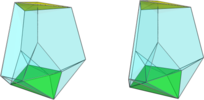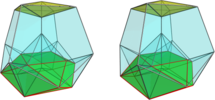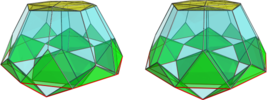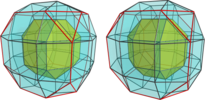Ursatope (EntityClass, 8)
From Hi.gher. Space
(→Magnaursatopes: Moving the details to its own page) |
m (→Magnaursatopes) |
||
| Line 41: | Line 41: | ||
== Magnaursatopes == | == Magnaursatopes == | ||
| - | In March 2016, [[User:Quickfur]] [http://hi.gher.space/forum/viewtopic.php?p=24541#p24541 discovered] that it is possible to construct a 4D analogue of the tridiminished rhombicosidodecahedron (J83) using a similar construction to the ursatopes. This has been | + | In March 2016, [[User:Quickfur]] [http://hi.gher.space/forum/viewtopic.php?p=24541#p24541 discovered] that it is possible to construct a 4D analogue of the tridiminished rhombicosidodecahedron (J83) using a similar construction to the ursatopes. This has been assigned [[D4.15]] and is currently informally referred to as the ''magnaursachoron'': |
<[#embed [hash CH1KW90ZT1ZBGJFKYCSM8YEZRN] [height 100]]> | <[#embed [hash CH1KW90ZT1ZBGJFKYCSM8YEZRN] [height 100]]> | ||
Revision as of 23:18, 14 March 2016
The ursatopes are bistratic polytopes that may be constructed from any polytope P. P with unit edge length, P scaled by the golden ratio, and rectified P with unit edge length, are placed in three parallel hyperplanes, the relative heights of which are adjusted such that vertices from the three layers line up to form pentagons. The convex hull of these three layers of vertices will be a polytope that has P as the top cell, rectified P as the bottom cell, and lower-dimensional ursatopes and pyramids lacing the two. If the resulting edge lengths are equal, the result will be a CRF (convex regular-faced) polytope.
History
Wendy Krieger discovered a bistratic polychoron constructed from the convex hull of a unit tetrahedron, a tetrahedron scaled by the golden ratio, and a unit octahedron. It consists of 4 tridiminished icosahedra surrounding a tetrahedron, with 4 more tetrahedra on the other end connecting the tridiminished icosahedra to an octahedron. This shape is in fact a 4D analog of the tridiminished icosahedron itself, which has been nicknamed "Teddy" by Klitzing (from Jonathan Bowers' acronym for the tridiminished icosahedron: teddi), a name which was quickly adopted by quickfur, although there is some confusion about the dimensions.
Subsequently, a whole class of similar shapes have been discovered, all containing tridiminished icosahedra, which may be referred to as ursatopes (a pun on "teddy").
List of ursatopes
In 2D, there is one ursatope: the digonal ursagon, which is the same as a pentagon.
In 3D, there is one CRF ursatope: the trigonal ursahedron, which is the same as the tridiminished icosahedron.
The other ursahedra, such as the square ursahedron and the pentagonal ursahedron (which is a diminished dodecahedron), are not CRF.
In 4D, there are three known CRF ursatopes:
- The pyroursachoron xfo3oox3ooo
 , with 5 tetrahedra, one octahedron and 4 tridiminished icosahedra;
, with 5 tetrahedra, one octahedron and 4 tridiminished icosahedra;
- The aeroursachoron xfo3oox4ooo
 , with an octahedron, a cuboctahedron, 8 tridiminished icosahedra and 6 square pyramids;
, with an octahedron, a cuboctahedron, 8 tridiminished icosahedra and 6 square pyramids;
- The hydroursachoron xfo3oox5ooo
 , with an icosahedron, an icosidodecahedron, 20 tridiminished icosahedra and 12 pentagonal pyramids.
, with an icosahedron, an icosidodecahedron, 20 tridiminished icosahedra and 12 pentagonal pyramids.
Other ursachora are possible, but it is believed that they are not CRF.
In 5D, there are believed to be the following CRF ursatopes:
- The pyroursateron, with 6 pyrochora, one rectified pyrochoron, and five pyroursachora.
- The aeroursateron, with an aerochoron, a xylochoron, 16 pyroursachora, and 8 octahedral pyramids.
- The xyloursateron, with a xylochoron, a rectified xylochoron, 24 aeroursachora, and 24 cubical pyramids.
- The hydroursateron, with a hydrochoron, a rectified hydrochoron, 600 pyroursachora, and 120 icosahedral pyramids.
In all higher dimensions n > 5, only two CRF ursatopes are believed possible:
- The pyroursatope: (n+1) pyro-(n-1)-topes, a rectified pyro-(n-1)-tope and n pyroursa-(n-1)-topes;
- The aeroursatope: an aero-(n-1)-tope, a rectified aero-(n-1)-tope, 2n-1 pyroursa-(n-1)-topes and (2n-2) aero-(n-2)-tope pyramids.
Expanded ursatopes
Expanded ursatopes may be constructed by expanding the facets of the top facet such that the ursatope facets are pushed apart. Prisms are inserted between the ursatope facets, causing the bottom facet to also expand, and the lacing pyramids to expand into cupolae. Expanded ursatopes may be used to construct higher-dimensional modified ursatopes in which the lacing facets are expanded ursatopes, etc.
Each of the three ursachora have corresponding expanded forms:
- The expanded pyroursachoron xfo3oox3xxx, with a cuboctahedron, a truncated octahedron, 4 tridiminished icosahedra, 6 pentagonal prisms, 4 triangular prisms and 4 triangular cupola (to be verified);
- The expanded aeroursachoron xfo3oox4xxx
 , with a rhombicuboctahedron, a truncated cube, 8 tridiminished icosahedra, 12 pentagonal prisms, 6 cubes and 6 square cupola;
, with a rhombicuboctahedron, a truncated cube, 8 tridiminished icosahedra, 12 pentagonal prisms, 6 cubes and 6 square cupola;
- The expanded hydroursachoron xfo3oox5xxx, with a rhombicosidodecahedron, a truncated dodecahedron, 20 tridiminished icosahedra, 30+12 = 42 pentagonal prisms and 12 pentagonal cupola (to be verified).
Magnaursatopes
In March 2016, User:Quickfur discovered that it is possible to construct a 4D analogue of the tridiminished rhombicosidodecahedron (J83) using a similar construction to the ursatopes. This has been assigned D4.15 and is currently informally referred to as the magnaursachoron:
It is surmised that higher-dimensional analogues are possible, using lower-dimensional ursatopes (including the above magnaursachoron) as facets. However, this has yet to be verified.
Currently, it is believed that analogues of this (tetrahedral) magnaursachoron with octahedral or icosahedral symmetry cannot be CRF, as the construction would require 3D ursahedra with square / pentagonal symmetry, which are non-CRF.

